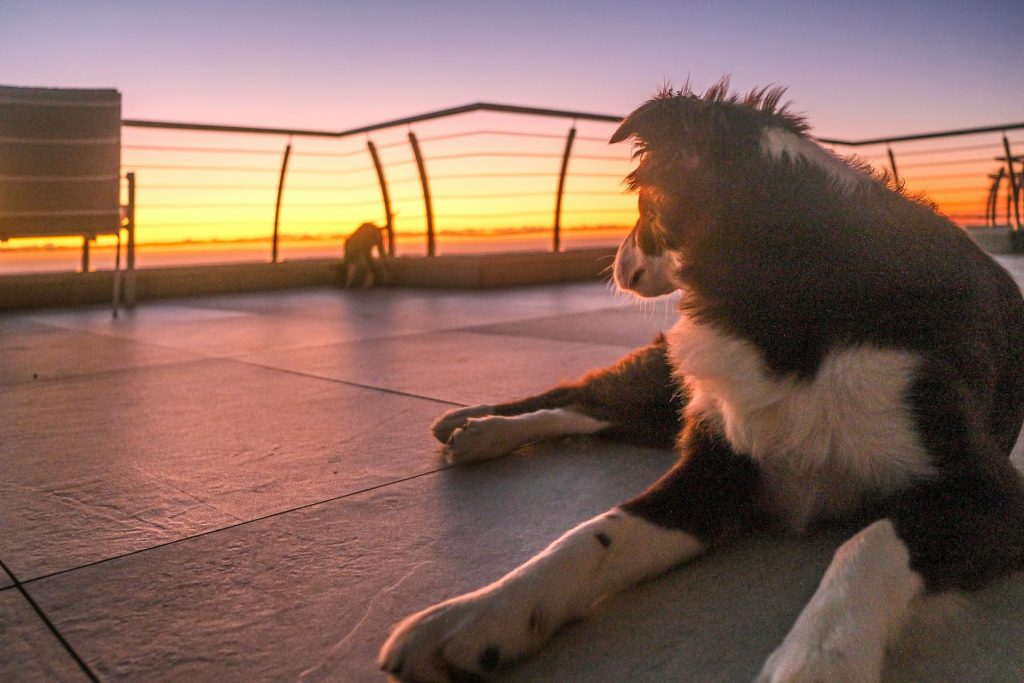
15 Smart Ways to Pet-Proof Your Balcony Without Sacrificing Style
A balcony can be a peaceful outdoor escape, even in a small apartment—but when you have pets, it comes with a few risks. Whether it’s a curious cat eyeing the edge or a dog slipping through the rails, making your balcony pet-safe is essential. Luckily, you don’t have to sacrifice style or renter-friendliness to do it. With a few clever upgrades and a bit of creativity, you can pet-proof your balcony and turn it into a secure space your furry companion will love. These 15 stylish, apartment-friendly tips will help you get there—without upsetting your landlord or your design sense.
1. Install Clear Balcony Shielding
Clear plastic balcony screens or plexiglass panels are an easy way to block the gaps between railings while keeping your view intact. They’re especially helpful for small dogs or cats who could squeeze through vertical or widely spaced bars. Look for weather-resistant materials with adjustable zip ties or brackets that don’t require permanent drilling.
Not only do these shields increase safety, they also reduce wind, making the space more comfortable for both you and your pets.
2. Use Heavy Planters as Natural Barriers
Instead of basic barriers, try lining your balcony edges with sturdy planters filled with pet-safe greenery. These act as natural fences while boosting your outdoor style. Be sure the plants are non-toxic to cats and dogs—great options include lavender, basil, or cat grass.
Just make sure planters are heavy enough not to tip over and placed close enough together to block access to the rails. It’s safety that doubles as decor.
3. Add a Privacy Screen for Comfort and Containment
A roll-up privacy screen or mesh fence cover not only adds visual privacy—it also discourages your pet from jumping, squeezing, or poking their head through railings. Choose breathable mesh or outdoor fabric that can be zip-tied in place and removed easily if you move.
Privacy screens also reduce distractions like passing dogs or birds that might trigger barking or lunging behavior. For more ideas, the AKC has balcony safety tips worth browsing.
4. Block Off Tight Corners with Furniture
Small balconies often have corners or nooks that curious pets love to explore—but these tight spots can hide hazards like electrical cords, AC units, or loose screws. Use outdoor-safe benches, plant stands, or weatherproof storage boxes to block access to these areas and double your storage.
Think of it as stylish space management that keeps your pet out of trouble and your balcony looking polished.
5. Lay Down Outdoor Rugs with Non-Slip Backing
Outdoor tile or concrete can be hot, rough, or slippery for pet paws. A weather-resistant rug with a grippy underside can provide traction, reduce slips, and create a cozy surface for your pet to lounge on.
Choose machine-washable or hose-cleanable options for easy maintenance. Neutral tones or woven textures add a touch of indoor comfort to your outdoor setup—without compromising function.
6. Use a Baby Gate to Control Access
Not all balconies need to be open 24/7. A pressure-mounted baby gate or freestanding playpen fence can block the doorway when you’re not supervising. It’s renter-friendly and requires no hardware, so you can add or remove it without damaging walls or trim.
Bonus: some indoor baby gates look surprisingly modern and sleek—so your apartment aesthetic stays on point even when safety comes first.
7. Create a Shaded Zone with a Patio Umbrella or Canopy
Direct sun can heat up balcony floors quickly, putting pets at risk for burned paws or heat exhaustion. Use a standing patio umbrella, small sun sail, or adjustable canopy to shade a section of your balcony throughout the day.
Make sure the shade structure is stable and wind-resistant. Not only does it protect your pet, it keeps your balcony usable even in the peak of summer.
8. Add a Pet-Friendly Chill Spot or Crate
Give your pet a reason to stay settled with a designated spot just for them. Use a waterproof dog bed, an elevated cot, or a soft-sided crate that’s designed for outdoor use. Cats may enjoy a perch or enclosed cube where they can safely observe the world.
Having a cozy, defined space helps pets associate the balcony with calm and comfort—not with climbing or darting around. Bonus points if it's shaded and non-slip!
9. Check for Small Items or Loose Hardware
Balconies often collect debris—fallen screws, cigarette butts from other units, or splinters from wood decking. Before letting your pet roam freely, do a quick safety sweep. Pick up any small items they could chew or swallow, and check for nails or sharp edges near railings.
This is especially important if you share a balcony with neighbors or if building maintenance is ongoing. A 60-second scan can prevent serious accidents.
10. Use Artificial Turf to Protect Paws and Flooring
Artificial grass tiles or turf rolls are an easy way to make balconies safer for paws. They stay cooler than concrete, offer grip, and give pets a grassy feel without the mess. Many versions are designed for drainage and can be rinsed off with a hose or bucket.
This option is especially great for dogs who don’t get yard time or cats who enjoy lounging on a soft surface. Choose lead-free, pet-safe turf with solid traction underneath.
11. Add a Balcony-Safe Enclosure or Catio
Want to give your cat or small dog a taste of the outdoors without risk? Consider a portable catio or balcony enclosure. These pop-up mesh tents or modular metal frames can attach to railings or stand alone in a corner.
Just be sure the enclosure is fully secure and weather-rated. Some models even fold flat when not in use—ideal for renters with limited space.
12. Avoid Toxic Plants and Unstable Décor
Balcony greenery is beautiful, but not all plants are safe for pets. Avoid lilies, aloe, pothos, and sago palm—all of which are toxic to cats and dogs. Choose pet-safe options like spider plants, bamboo, or herbs like parsley and rosemary.
Also avoid top-heavy planters, dangling string lights, or wobbly chairs that could fall if bumped. Stability and safety should always come before aesthetics—though you’ll find there’s room for both.
13. Supervise All Balcony Time (Until You’re 100% Sure)
Even with all the safety upgrades, you should always supervise your pet on the balcony—especially during the first few uses. Some pets may try to jump, squeeze, or chew unexpectedly, so watch closely until you’re confident in their behavior.
If you need to step inside, bring your pet with you or install a baby gate until they’ve learned the balcony rules. Vigilance is the best safety tool you’ve got.
14. Use Pet Cameras for Extra Peace of Mind
If your pet has balcony access while you’re away—even if limited—a pet camera can help you keep an eye on things. Look for indoor/outdoor cams with motion detection or real-time alerts. You’ll know immediately if your pet is pacing, barking, or getting into something risky.
While cameras aren’t a substitute for supervision, they add another layer of reassurance—especially in high-rise buildings or hot climates.
15. Keep Emergency Contacts Posted Near the Door
It might sound extreme, but having a vet’s number or emergency pet contact near the balcony door can save precious minutes in case of a fall or heat-related emergency. If you live in a high-rise, it’s worth checking if your building has a designated pet safety policy too.
Better safe than sorry—especially when a few seconds can make a big difference in your pet’s safety and recovery.
Final Thoughts
Your balcony doesn’t have to be off-limits to your pet—it just needs a little smart planning. With these pet-proofing ideas, you can turn even the smallest outdoor space into a cozy, secure haven for your four-legged roommate. Whether you’re installing safety barriers or adding cozy crates and turf, every thoughtful detail adds to your pet’s well-being—and your peace of mind. With the right setup, your balcony can become a daily retreat for both of you.
Frequently Asked Questions
Is it safe for pets to go on the balcony?
Yes—if it's been properly pet-proofed. Always use barriers to block gaps, add shade to prevent overheating, and avoid toxic plants. Supervision is key until your pet is reliably calm and the space is fully secure.
What’s the best way to keep my cat from jumping off the balcony?
Install mesh screens, clear panels, or a secure catio to prevent risky jumps. Cats can leap surprisingly far—even from stillness—so full enclosures are often the safest option in multi-story apartments. For ideas, see this guide from the AKC.
Can I pet-proof my balcony if I’m renting?
Absolutely. Most of the tips in this guide use removable, damage-free products like zip-tied mesh screens, free-standing barriers, or temporary turf. You don’t need to drill holes or alter permanent structures to keep your balcony pet-safe.
Are there pet-safe plants I can use on my balcony?
Yes! Great options include spider plants, cat grass, basil, rosemary, and bamboo. Always check the ASPCA or your vet’s list of toxic plants before adding greenery. Avoid lilies, aloe, and sago palm.
How hot is too hot for pets on balconies?
If you can’t comfortably press your hand to the balcony floor for 10 seconds, it’s too hot for paws. Provide shade, cool mats, and fresh water, and avoid balcony time during peak sun. For general pet safety in heat, see this vet-approved guide.

Join the Busy Pet Parent Newsletter!
Get easy routines, time-saving tips, and the latest gear reviews—delivered straight to your inbox.
Perfect for busy pet owners, apartment dwellers, and anyone who wants a happy, healthy companion (without the stress).
Exclusive guides & checklists
Product recommendations & deals
No spam—unsubscribe anytime!




